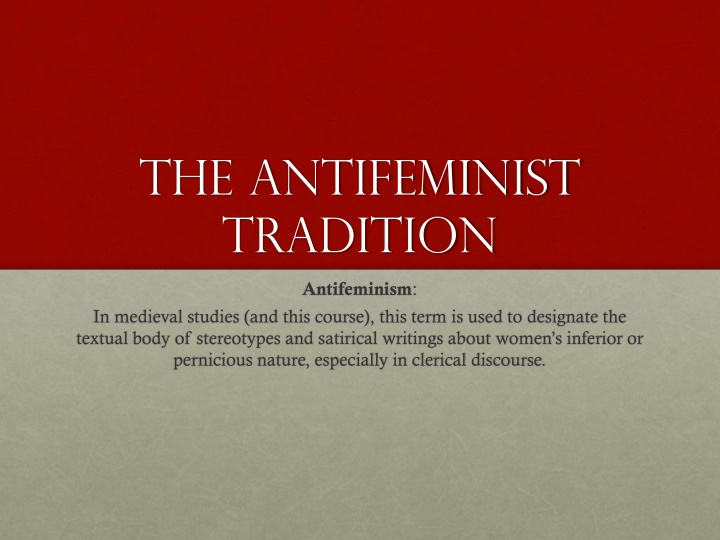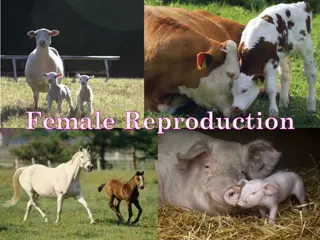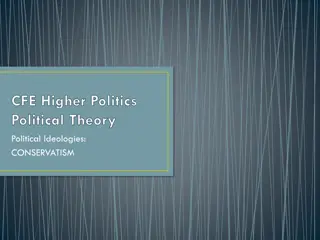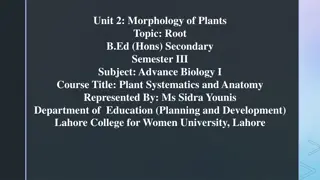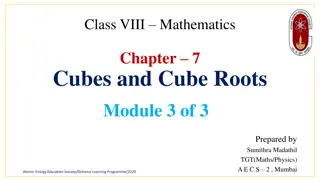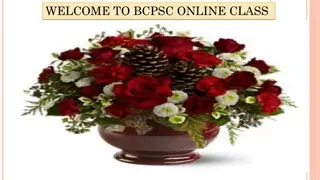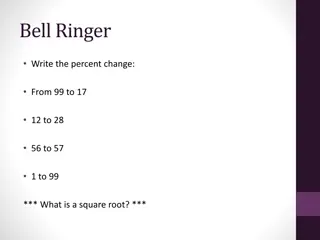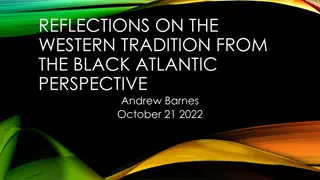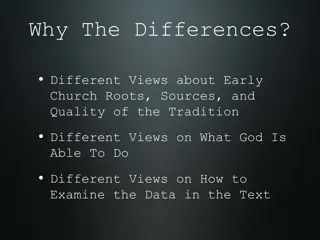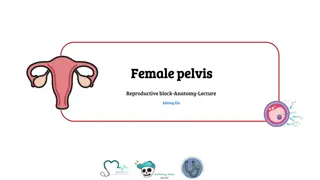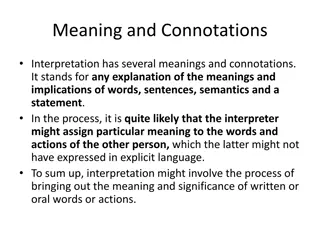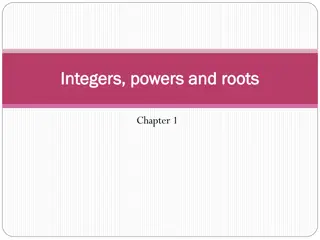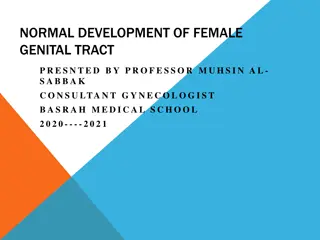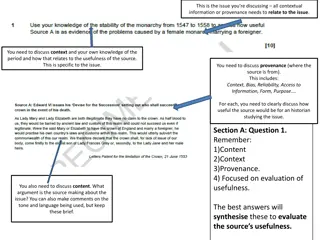Unveiling the Antifeminist Tradition: Ideological Roots, Textual Sources, and Female Nature
Explore the antifeminist tradition in medieval studies through a deep dive into its ideological roots, main textual sources, and portrayal of female nature. Discover how stereotypes and satirical writings about women's perceived inferiority have persisted throughout history, informed by clerical, institutional, and anthropological influences.
Download Presentation

Please find below an Image/Link to download the presentation.
The content on the website is provided AS IS for your information and personal use only. It may not be sold, licensed, or shared on other websites without obtaining consent from the author.If you encounter any issues during the download, it is possible that the publisher has removed the file from their server.
You are allowed to download the files provided on this website for personal or commercial use, subject to the condition that they are used lawfully. All files are the property of their respective owners.
The content on the website is provided AS IS for your information and personal use only. It may not be sold, licensed, or shared on other websites without obtaining consent from the author.
E N D
Presentation Transcript
The antifeminist tradition Antifeminism: In medieval studies (and this course), this term is used to designate the textual body of stereotypes and satirical writings about women s inferior or pernicious nature, especially in clerical discourse.
Ideological Roots of antifeminism: 1. Clerical/ecclesiastical: the Church s efforts to encourage a celibate priesthood to remain steadfast in its resistance to the charms and wiles of the two-legged she-beast (Richard de Bury, Philobiblon, ca. 1345). 2. Institutional: antifeminist stereotypes justified and preserved the status quo whereby aristocratic, wealthy, and/or educated men wielded hegemonic power in every social and cultural institution; Alcuin Blamires thus notes in antifeminist writings a male determination to defend an inherited domain of intellectual pursuits aggressively against female encroachment (Women Defamed, p. 6). 3. Anthropological: behind both of these factors lay a deeply rooted prejudice against and fear of women in Ancient Greek, Roman, Judaic, and Christian cultures and textual authorities.
Main textual sources of antifeminism: Selectively chosen passages from Biblical books of Proverbs, Ecclesiastes, and Ecclesiasticus (an apocryphal book). The second creation account, the story of the fall, and Eve s punishment in Genesis. Stories about patriarchs or other Biblical heroes who succumbed to sexual temptation (e.g., David and Samson). The Epistles of Paul in the New Testament. Aphorisms (short, witty sayings or proverbs) from celebrated Roman authors such as Ovid, Juvenal, and Virgil and from Patristic authors such as Augustine and Jerome. Jerome s Against Jovinian (written in the 4th century AD but widely copied in the 12th century). Walter Map s Letter of Valerius (Map was a 12th-century, Welsh-born cleric) Anonymous Latin and vernacular proverbs.
Female nature according to antifeminism Excessively emotional and deficient in reason BUT wily and clever in a devious, quick-witted way. Excessively sexual and bodily BUT physically weak and passive. Lacking in self-control; incontinent : unable to control speech, a leaky vessel. Resentful and prone to use manipulation and nagging to get their way because they have no recourse to direct means of power. Vain, greedy, and materialistic. Female beauty the result of artifice: beauty on the surface but corrupt underneath. This idea understood in a figurative way (physical beauty = moral corruption) and a literal way (cosmetics, perfumes, clothing hiding general ickiness like menstrual blood and other unspeakable matter).
Female nature in sum: Women were often considered the embodiment, or ultimate symbol and reminder of earthly sin per se: like sin itself, they were sources of temptation but they were dangerous, repugnant when seen clearly, and always in need of control, denial, and suppression.
Medieval marriage: barley bread? Typical age for marriage: legal minimum was 12 for girls, 14 for boys, but marriage in late teens and twenties was more typical for aristocrats and peasants often married even later. In 1377 (year of Richard II s poll tax): Total population of England: 2.5 million Total adult population: 1.5 million Total members of clergy: 30, 641
Womens property rights in marriage England practiced non-partible inheritance and male primogeniture since the late 11thcentury. A daughter could inherit land if there were no sons; if there were multiple daughters and no sons, they could inherit jointly. Land owned by heiresses under 14 was controlled by a legal guardian, who often arranged advantageous marriages for their wards at that time. Upon marriage, the title of the heiress s land remained hers, but her husband could do anything with it except sell or give it away without her consent: he could use it, lease, it, mortgage it, control all profits from it. Apart from land, any personal property owned by a woman before marriage (livestock, furniture, jewelry, even clothing) became the absolute property of her husband upon marriage.
Coverture: Anglo-American common-law concept, derived from feudal Norman custom, that dictated a woman s subordinate legal status during marriage. Prior to marriage a woman could freely execute a will, enter into contracts, sue or be sued in her own name, and sell or give away her real estate or personal property as she wished. Once she married, however, her legal existence as an individual was suspended under marital unity, a legal fiction in which the husband and wife were considered a single entity: the husband. The husband exercised almost exclusive power and responsibility and rarely had to consult his wife to make decisions about property matters. Coverture rendered a woman unable to sue or be sued on her own behalf or to execute a will without her husband s consent and, unless some prior specific provision separating a woman s property from her husband s had been made, stripped a woman of control over real and personal property. (Encyclopedia Britannica)
Virginity: white bread? Spiritual ideal established by St Paul and enshrined by Church Fathers. WHY??? How can we account for the fact that virginity became such an important value, perhaps the most important value for Christian praxis, in early and medieval Christianity? How does Jerome present and defend virginity in Against Jovinian? Are the virgin saints Lucy and Agatha empowered agents or do these stories create glorified spectacles of violence against women? Would Lucy and Agatha have the same power if their opponents succeeded in raping them/forcing them to lose their virginity?
